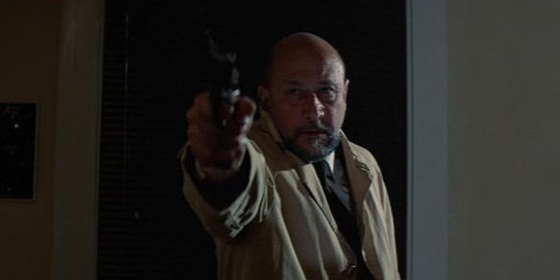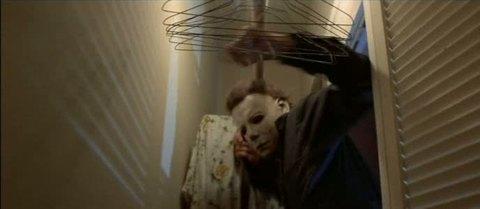Halloween (1978)

Director: John Carpenter
Cast: Jamie Lee Curtis, Donald Pleasence, Nick Castle, Tony Moran, Will Sandin, P.J. Sores, Nancy Loomis, Charles Cyphers
Running Time: 91 Minutes
Original Release Date: October 25, 1978
Tagline: The Night HE Came Home!
Plot: Young Michael Myers is committed to Warren County's Smith's Sanitarium after stabbing his older sister Judith to death. Fifteen years later, grownup Michael escapes and returns to his home town of Haddonfield to go on a killing spree on Halloween night.
The original Halloween is the defining film in kick starting what we now know as the Slasher movie. Not only is it the perfect slasher movie, but one of the truly great horror movies. One thing that makes it such a memorable horror movie is that its a classic example of low budget DIY filmmaking, a style which was a core characteristic of many of the best movies of the 1970's. It had been proven many times before Halloween and since that horror is a genre which benefits from being scaled back. The film's budget came in somewhere around the $300,000 mark. As a result Carpenter was able to foster a great sense of mystery, and dread into his small town setting. The flow of the scenes feel naturalistic, with character interactions taking just the right amount of time. An example of this is the scene with Laurie and Annie in the car early in the film. The dialogue flows perfectly between them as if they are realistic teenagers, but the lingering sense of the scene builds up a suspense of if something is bad around the corner? Such scenes like this and the one where Laurie and Annie walk home with Laurie believing she sees someone lurking in the bushes set the tone for the movie. It suggests like Myers could strike at any moment, but also that the real fear is in not knowing one way or the other.

Carpenter's direction is a masterclass, working with a tightly plotted script co-written with Debra Hill (she also produced the film and is a crucial collaborator with Carpenter on some of his best work). For much of the film Carpenter's camera drifts around the sleeping looking Haddonfield suburbs. One eerie shot comes from Michael's POV as he looks out from his car onto the town. This shot creepily places the viewer from Michael's position as someone stalking the town, waiting for the right moment to ponce. Throughout Carpenter manipulates the viewer's expectations. Keeping them guessing if something is really about to happen or not. Its not even made clear whether its Michael in the car following Laurie and her friends. Another effective touch is how we see a lot of Michael in short busts during the first half of the film, but only see certain body parts, never seeing his face clearly til later in the film. This stays true to the classic horror rule of protecting the mystery of the monster as much as possible so that the big reveal moment has all the more impact. The camera drifting in and out of focus, taking up multiple positions, gives the film at times a surreal and off kilter tone which is perfectly contrasted with the finely judged set pieces and realism of the human interactions. The pacing of script allows Carpenter to play with space and time, capturing the power of suggestion rather than showing too much too soon. The setting of Haddonfield becames like a character in itself with the director using every inch of its setting to devastating effect.
Of course the use of sound and music is such a big part of Carpenter's films. Because he produces most of the music for his films its another way Carpenter stamps his authorial signature onto his films. The Halloween theme is one of his most iconic and has a chilling presence at various times throughout. Outside of that main theme the music is use sparingly. Much of the mystery and drama of the horror playing out is because the dead air and long pauses in dialogue, which are then pieced by a nicely judged piece of music and or sound at just the right moment.
Another thing which stands out is the quality of the characters and the casting. This was the first time that the idea of "The Final Girl" was introduced. Part of the reason Laurie Strode stands out so much as the classic final girl is because Jamie Lee Curtis was a virtual unknown at the time. This immediately gives Laurie a tangible, everyday girl next door vibe. The character as fleshed out is likeable, smart and vulnerable. Curtis's performance matches that. She psychically embodies the character, and sells every little tick and emotion perfectly. Curtis sells Laurie's terror so effectively. The scene when she discovers her dead friends and is first confronted by Michael is one of the great horror sequences of all time. Curtis's performance along with the character's depth makes you root for Laurie. Without Laurie there wouldn't have been a Nancy in A Nightmare on Elm Street or a Sidney in the Scream movies. The dynamic between Laurie and her friends Lynda (P.J. Soles) and Annie (Nancy Loomis) is credible and their distinct characters again influenced future slasher movies.

The other important character is Dr. Sam Loomis played by to excellent effect by Donald Pleasence. At this stage Pleasence was already an established character actor with film credits including The Great Escape, You Only Live Twice and Wake in Fright under his belt before being cast for this original Halloween. Interesting fact that Christopher Lee (who also played a Bond Villain) was close to taking the role as Loomis and ultimately regretted the decision to turn it down. It says something that the part would end up defining Pleasence. The macabre strangeness of his connection to Michael/The Shape is a big selling point. Pleasence's heightened performance gets across the desperation of Loomis to try and get to Michael and control him before he does much damage. As well as his frustration at not being believed about the threat posed by the escaped killer. Pleasence's performance skilfully blends the hammy mad scientist aspect of old horror with a more caring and compassionate humanity. Loomis's role in the series is just as important as that of Myers or Laurie.

Myers presence is one of the most haunting and visually distinctively in horror. The idea of him being more of a thing or unknown entity is another powerful aspect to the character. He lacks any reasoning or humanity, and is cold and machine like in how he stalks his victims. Some of the back and forth between him and Laurie is really gruelling stuff. The physicality of their sequences is impressive. There are some inventive set pieces both involving Laurie and some of the kill sequences. The open ended finish to the movie when Michael just vanishes having been shot multiple times and assumed dead was something very rarely seen in mainstream horror at least in this era. It was a smart choice not only because it left the door open for a sequel, but because it added more mystery and threat to the monster of the piece. The closing shots panning around the deserted town with the eerie sounds of breathing is a great way leave the viewer in a uncertain place. The message being that Michael is still out there and terrorising the small community.



Best Scene: The one when Laurie first discovers her friends dead and is confronted by Myers. Michael using the gravestone of his dead sister is also a choice visual.
Best Dialogue:
Laurie Strode: "It was the Boogeyman?"
Dr. Sam Loomis: "As a matter of fact, it was."
Rating: 10/10
I should be back with a review of the first sequel Halloween II sometime in the next week. In meantime feel free to comment on the review and the film below.
No comments:
Post a Comment